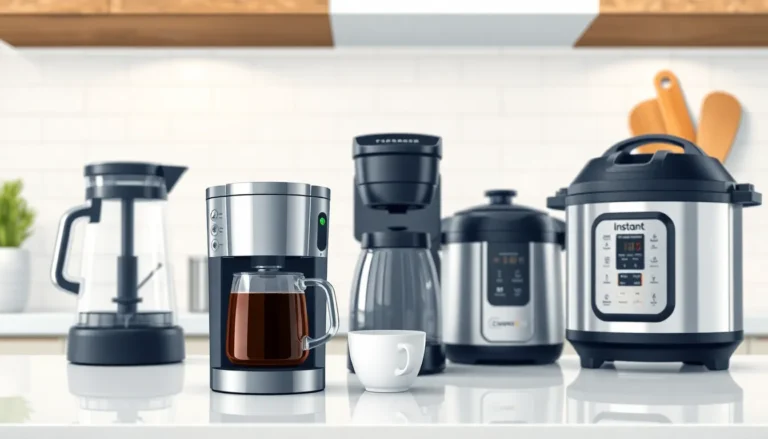In a world where gadgets rule our lives, why not take a crack at building your own? Imagine crafting a device that not only impresses friends but also makes you feel like a modern-day MacGyver. From quirky kitchen tools to clever tech solutions, the possibilities are endless. Plus, it’s a fantastic way to channel your inner inventor while avoiding those pesky assembly instructions that read like ancient hieroglyphics.
Table of Contents
ToggleUnderstanding Building Gadgets
Building gadgets encompasses the exciting process of creating and designing devices that serve practical or creative purposes. This venture encourages innovation and allows individuals to bring personal ideas to life.
What Are Building Gadgets?
Building gadgets refers to the DIY creation of devices or tools designed for specific functions. Examples include homemade smart home systems, custom robotics, and innovative kitchen appliances. These gadgets typically combine various materials and technologies, like electronics, programming, and mechanics, to achieve their desired outcomes. The versatility in design and purpose allows builders to cater to personal needs, enhancing daily life or tackling unique challenges.
Importance of Building Gadgets in Modern Life
Building gadgets plays a crucial role in modern life by fostering creativity, problem-solving, and hands-on technical skills. They encourage individuals to understand technology and adapt it to their circumstances. These DIY creations often lead to cost savings compared to commercial products, while also promoting sustainability through repurposing materials. Embracing this practice cultivates a sense of achievement and empowers individuals to be more self-sufficient, which is increasingly valued in today’s technology-driven world.
Types of Building Gadgets

Building gadgets includes various categories that enhance everyday life through creativity and innovation. Each type offers unique features and functionalities.
DIY Electronics
DIY electronics projects encompass assembling and designing custom devices. These gadgets range from simple circuits to complex audio systems. Tools like breadboards, microcontrollers (e.g., Arduino), and soldering kits enable enthusiasts to create personalized solutions. Individuals can build everything from basic LED displays to advanced sensors and home monitoring systems, enhancing their understanding of electronics while having fun.
Home Automation Devices
Home automation devices allow individuals to automate everyday tasks efficiently. Examples include smart lights, automated thermostats, and security systems. Using platforms like Raspberry Pi or smart home hubs, users can create customized systems that integrate with existing home technologies. These gadgets not only improve convenience but also promote energy savings and security.
Robotics Kits
Robotics kits provide hands-on experience in building robots with various functionalities. Kits typically include motors, sensors, and programmable components, allowing users to design and program robots for specific tasks. Projects can range from simple line-following robots to advanced drones. Engaging with robotics fosters problem-solving skills and encourages creativity in technology application.
Materials and Tools for Building Gadgets
Building gadgets requires specific materials and tools. Choosing the right ones can make the construction process smooth and enjoyable.
Essential Tools for Beginners
- Screwdriver Set: Includes both flat-head and Phillips screwdrivers for assembling and disassembling components.
- Wire Strippers: Essential for stripping insulation off electrical wires, facilitating proper connections.
- Soldering Iron: Necessary for joining circuit components; allows for strong, reliable connections.
- Multimeter: Used to measure voltage, current, and resistance, ensuring circuits function correctly.
- Hot Glue Gun: Provides an effective method for attaching various materials securely.
Recommended Materials for Projects
- Microcontrollers: Arduino and Raspberry Pi serve as versatile brains for electronics projects, aiding in automation and innovation.
- Breadboards: Ideal for prototyping, allowing quick changes to circuit designs without soldering.
- Resistors: Common components control electrical flow, essential for preventing circuit damage.
- LEDs: Employed for visual indicators, they’re useful in a wide range of gadget designs.
- Wires: Available in various gauges, wires connect circuits and components, ensuring reliable power delivery.
Getting Started with Your First Gadget
Embarking on the journey of gadget building requires foundational knowledge and practical steps. Understanding the process can empower individuals to create their unique inventions effectively.
Step-by-Step Guide
- Identify the Idea: Choose a gadget that sparks interest, ensuring it meets a practical need or aligns with personal hobbies.
- Gather Materials: Collect necessary components like microcontrollers, sensors, and wiring to facilitate the project.
- Create a Prototype: Use a breadboard for testing circuits before final assembly, allowing for changes without commitment.
- Assemble the Gadget: Follow a structured approach to connect components as planned, ensuring proper connections for functionality.
- Test and Troubleshoot: Power the gadget on and observe performance. Make adjustments as necessary to address any issues encountered.
Common Mistakes to Avoid
- Skipping Planning: Failing to outline the design can lead to confusion and errors during assembly.
- Underestimating Skills: Taking on overly complex projects without prior experience often results in frustration or incomplete builds.
- Ignoring Safety: Neglecting safety precautions, such as not using suitable tools or working on live circuits, can lead to accidents.
- Overcomplicating Designs: Striving for elaborate gadgets may overwhelm beginners; starting simple often yields better results.
- Forgetting Documentation: Not keeping track of designs and modifications can lead to difficulties when replicating or troubleshooting gadgets.
Embracing the world of DIY gadget building opens up a realm of creativity and innovation. It empowers individuals to transform ideas into tangible devices that enhance everyday life. This journey not only fosters technical skills but also nurtures problem-solving abilities and self-sufficiency.
As they experiment with various materials and tools, builders gain valuable insights and a sense of accomplishment. Whether creating smart home devices or custom robotics, the satisfaction derived from these projects is unparalleled. With the right approach and a willingness to learn, anyone can dive into this rewarding hobby and uncover their potential as an inventor.



